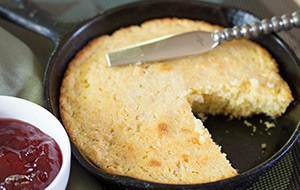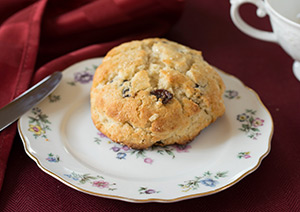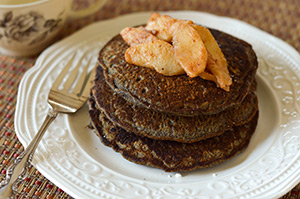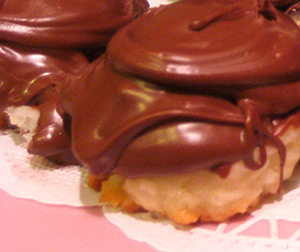E-News Exclusive
The Art of Gluten-Free Baking
By Marlisa Brown, MS, RD, CDE, CDN
The sweet smell of fresh baked goods is so enticing that many clients will find it hard to resist eating them. However, for clients with celiac disease or nonceliac gluten sensitivity the aroma can be torturous, as almost all standard baked goods contain gluten, which they must avoid. But it’s the gluten in wheat flour that produces those tiny air pockets that give bread and pastries their light, fluffy texture. These air pockets are formed when the protein in gluten expands during baking. Duplicating this texture is partly why gluten-free baking can be a bit complicated; without the gluten, those tiny air pockets don’t naturally form, so you want to come as close to reproducing them as possible.
To that end, gluten-free baked goods need specific combinations of different types of flours and other added ingredients to achieve results similar to those of wheat flour. If you try to bake with a single gluten-free flour, such as rice flour, you’ll end up with a dense, heavy, chewy, inedible mass. Delicious gluten-free baked goods require an artful combination of a light flour (eg, millet flour or potato or tapioca starch) combined with a base flour (eg, rice or sorghum flour), along with a higher-protein flour or ingredient (eg, milk powder, quinoa flour, or bean flour) and a leavening agent and/or gum (eg, baking powder, xanthan gum, or guar gum). Light flours—or, more often, some type of starch—have less density and produce a much lighter texture than other denser flours. A base flour, on the other hand, has some starch along with a small amount of protein and typically some fiber as well. Because wheat generally has a lower pH than gluten-free flours, ingredients that change the pH, such as vinegar, buttermilk, or seltzer water, are sometimes included to enhance texture.
Becoming adept at using these flour combinations will be daunting to most clients who have little experience with gluten-free baking. But the good news is they don’t have to purchase several different types of flours. Today, there are many premixed gluten-free flour blends available, and the variety continues to grow. But while using these premixed flour blends is convenient, incorporating different flour combinations can add extra flavor and texture. These flours include amaranth, almond meal, buckwheat, bean, chestnut, coconut, corn, green pea, mesquite, millet, montina, gluten-free oats, rice, soy, sweet potato, teff, and wild rice flour. To keep gluten-free flours fresh, clients should seal and store them in the refrigerator. For added nutrients, they can incorporate flax or chia seeds into their flour blends.
To simplify gluten-free baking for clients, recommend they start with a gluten-free, all-purpose flour blend and add additional flours for flavor and texture along with a leavening agent such as xanthan gum and/or a little extra gluten-free baking powder. For clients with little to no experience, suggest they start with commercially prepared gluten-free baking mixes for cakes or brownies, then encourage them to experiment with additional ingredients with each future batch.
Many manufacturers are known for their high-quality gluten-free flours. Some have dedicated gluten-free facilities and some don’t, so it’s important for clients to check labels to avoid purchasing products that could contain traces of gluten due to cross-contact. The following are websites of some companies that produce gluten-free flours: BobsRedMill.com, FirebirdMills.com, PamelasProducts.com, Glutino.com, KingArthurFlour.com/glutenfree, MehlsFlour.com, Nuts.com, and Shop.BetterBatter.org.
Below are some of my favorite gluten-free recipes made with gluten-free flours that dietitians can share with clients.
— Marlisa Brown, MS, RD, CDE, CDN, (@MarlisaBrownRD) is an award-winning dietitian, certified diabetes educator, chef, and professional speaker. She’s been the president of Total Wellness, Inc, in Bay Shore, New York, for 22 years and is the author of Gluten-Free, Hassle-Free; The Gluten-Free, Hassle-Free Cookbook; and Easy, Gluten-Free.
Recipes
Skillet Corn Muffins • Cranberry Almond Scones • Buckwheat Oatmeal Pancakes With Cinnamon Apples • Chocolate-Covered Macaroons
Skillet Corn Muffins
 Serves 18
Serves 18
Ingredients
1 stick unsalted butter, softened
1/3 cup sugar
2 eggs
1 cup buttermilk (or 1 cup whole milk mixed with 1 tsp white vinegar)
1 tsp vanilla extract
3/4 cup gluten-free, all-purpose flour blend
1 cup corn meal
1 tsp xanthan gum
1 tsp salt
1 tsp baking powder
Gluten-free cooking spray or 1 tsp olive oil
Directions
- Preheat oven to 375° F.
- Cream together butter and sugar. Add eggs, buttermilk, and vanilla extract, and mix until well combined.
- Combine dry ingredients and slowly beat into wet ingredients until uniform in texture.
- Pour batter into muffin tins, or into four mini cast iron skillet pans coated with cooking spray, or a 12 x 9 x 3-inch cake pan coated with cooking spray.
- Bake muffins or skillet corn cakes about 20 minutes (25 minutes if using a cake pan), until golden and a toothpick comes out clean.
Note: If you make corn bread in a larger cake dish, it will come out very thin like a toaster corn cake.
Nutrient Analysis per serving
Calories: 279; Total fat: 13 g; Sat fat: 7 g; Trans fat: 0 g; Cholesterol: 71 mg; Sodium: 417 mg; Total carbohydrate: 36 g; Dietary fiber: 1 g; Sugar: 9 g; Protein: 4 g
Cranberry Almond Scones
 Serves 8
Serves 8
Ingredients
1/2 cup sorghum flour
3/4 cup white rice flour
1/2 cup tapioca flour
1/4 cup almond flour
1/4 cup granulated sugar
1 T gluten-free baking powder
1/2 tsp sea salt
1/2 cup (8 T) cold unsalted butter
1/4 cup dried cranberries
1 tsp orange zest
2 T slivered almonds
1 egg
3/4 cup half and half
Directions
- Preheat oven to 450° F. Line a baking sheet with parchment paper.
- In a large bowl, whisk together flours, sugar, baking powder, and salt. Cut in butter with pastry blender or two knives until mixture is crumbly.
- Add cranberries, orange zest, and almonds to flour mixture.
- Whisk together egg and half and half. Stir into flour mixture until just combined.
- Place dough between two sheets of waxed paper. Pat out into a 7-inch circle. Cut into eight wedges (or 2-inch rounds using a biscuit cutter) and place on prepared baking sheet.
- Bake for 13 to 15 minutes.
Tip: Scones are very versatile. You can make them plain or add your favorite combinations of fruit and nuts. If you want to glaze them, mix 1/2 cup powdered sugar with 1 to 2 T half and half, and drizzle on top.
Nutrient Analysis per serving
Calories: 319; Total fat: 18 g; Sat fat: 3 g; Trans fat: 0 g; Cholesterol: 62 mg; Sodium: 291 mg; Total carbohydrate: 37 g; Dietary fiber: 2 g; Sugar: 9 g; Protein: 5 g
Buckwheat Oatmeal Pancakes With Cinnamon Apples
 Serves 4
Serves 4
Ingredients
Apples
3 small apples
1 tsp pure vanilla extract
1 tsp ground cinnamon
1/4 tsp ground nutmeg
1 T unsalted butter
Pancakes
3/4 cup buckwheat flour
1/4 cup oat flour
1/2 cup white rice flour
3 T granulated sugar
1/2 tsp ground cinnamon
1/2 tsp sea salt
1 tsp baking soda
1/2 cup unsweetened applesauce
1 cup (8 oz) low-fat milk
Gluten-free cooking spray or 1 tsp olive oil
Directions
- Peel and slice apples about one-half inch thick. Mix with vanilla, cinnamon, and nutmeg.
- Melt butter in a medium-sized skillet over medium heat. Add apples and cook, stirring occasionally, until apples are tender and browned. Remove from heat and set aside.
- In a large bowl, whisk together flours, sugar, cinnamon, salt, and baking soda. Stir in applesauce and milk until combined.
- Heat a griddle or nonstick frying pan over medium heat. Spray with cooking spray. Pour batter by 1/4-cup measures onto the hot surface. Cook for 2 to 3 minutes on the first side, then flip over and cook 1 to 2 minutes more, or until nicely browned.
- Serve with warm apples.
Note: Keep warm in 250° F oven until all pancakes are cooked and ready to serve.
Nutrient Analysis per serving
Calories: 229; Total fat: 3 g; Sat fat: 1 g; Trans fat: 0 g; Cholesterol: 2 mg; Sodium: 425 mg; Total carbohydrate: 47 g; Dietary fiber: 5 g; Sugar: 12 g; Protein: 5 g
Chocolate-Covered Macaroons
 Serves 18
Serves 18
Ingredients
1 1/3 cups sweetened coconut
1/3 cup granulated sugar
3 T brown rice flour
1/2 tsp salt
2 egg whites
1/2 tsp almond extract
Gluten-free cooking spray
3/4 cup gluten-free chocolate chips (semisweet or milk chocolate)
Directions
- Preheat oven to 325° F.
- Mix together coconut, sugar, flour, salt, egg whites, and almond extract until well combined.
- Spray a baking sheet with cooking spray.
- Using a 1 T cookie scoop, place macaroons on baking sheet.
- Bake for about 10 minutes until golden, taking care not to burn bottom of the cookies.
- Remove macaroons from the baking sheet with a spatula and place on aluminum foil to cool.
- Meanwhile, place chocolate chips in a small glass bowl and microwave for about one minute and stir. Then microwave the chips for another 15 to 30 seconds until creamy and stir again.
- Pick up the macaroons from the bottom and dip top of cookie into the chocolate mixture, rotating to coat the whole top of the macaroon with chocolate.
- Place macaroons back on the aluminum foil and let them cool for one or more hours until chocolate is hard.
- Store in airtight container until ready to eat.
Tip: You also can spread 1/2 tsp of jam on each macaroon before baking and omit the chocolate.
Nutrient Analysis per serving
Calories: 68; Total fat: 3 g; Sat fat: 2 g; Trans fat: 0 g; Cholesterol: 0 mg; Sodium: 78 mg; Total carbohydrate: 10 g; Dietary fiber: 1 g; Sugar: 8 g; Protein: 1 g
— Recipes reprinted with permission from demosHEALTH from The Gluten-Free, Hassle-Free Cookbook by Marlisa Brown, MS, RD, CDE, CDN.
— Photos by Marlisa Brown, MS, RD, CDE, CDN.
